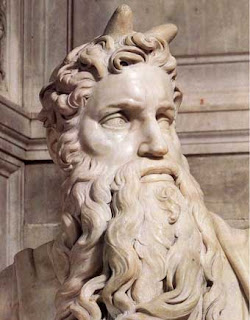The Moses is one of the most famous Michelangelo Buonarrotti´s sculptures. Michelangelo sculpted it as part of Pope Julius II tomb. It´s an impressive marble sculpture located in the small church of San Pietro in Vincoli in Rome, the church of the Della Rovere family. Michelangelo considered the Moses to be his most life-like creation and there is a legend that says that when he finished it, he struck the statue´s knee and said " Now speak!".
But one of the most shocking aspects of the Moses is that the prophet seems to have horns. This was the common way of representing Moses in iconography, but the origin of this representation lies on a translation mistake. Saint Jerome, the translator of the Bible from Hebrew to Latin, made a mistake. When he translated the paragraph that explains the moment when Moses came down from Mount Sinai, he made a mistake with the word karan, which can mean "brightness" and also "horn" in Hebrew. The context of this story of the Bible suggests that Moses´s head was surrounded by some kind of halo, but Saint Jerome wrote "horns" instead of "halo" and this conditioned many further representations of Moses in art history.


2 comments:
It's an interesting philological problem. I suggest that an Arabic cognate could provide a new solution:
http://aplaceofbrightness.blogspot.com/2010/08/on-horns-of-philological-dilemma.html
Thanks for the information. I´m not an expert. I only knew the traditional story about the horns. Thanks for visiting!
Post a Comment